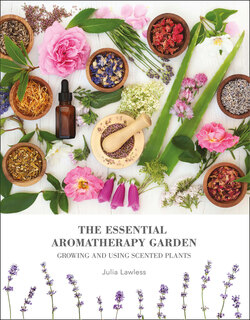Читать книгу The Essential Aromatherapy Garden - Julia Lawless - Страница 8
ОглавлениеTHE PERSIAN GARDEN AS AN IMAGE OF PARADISE
The very concept of creating a scented garden is rooted in ancient history. From the earliest times, the culinary and medicinal properties of herbs and aromatic plants have made them a vital part of human existence. From material necessity to aesthetic pleasure is a short step and historical records suggest that the first scented gardens were planted within the enclosed courtyards of Persian palaces over 2,500 years ago.
These gardens were made not only to delight the senses but also to provide a spiritual sanctuary, quite apart from any practical benefits they conferred. Since the Koran taught that it was mankind’s duty to conserve and revere nature as part of the divine creation, these sacred gardens were looked upon as a means of recreating and experiencing heaven on earth.
The term ‘paradise’ derives from the Greek word paradeisos, which in turn was based on the Persian, pairidaeza, literally ‘surrounded by walls’. This referred to an enclosed garden of pleasure, an earthly paradise where both secular and sacred elements were intertwined. The classical Persian garden was constructed to a formal plan within a square or rectangle, having a fountain in the centre from which four streams issued – one in each direction. The whole area was then carefully planted with fruit-bearing and fragrant trees, aromatic herbs and flowers, for the Persians required three main qualities in their paradise gardens: running water, shade and scent.
Canals and fountains in the garden of Qavam House, Iran, built 1879–1886.
Borna_Mirahmadian
An orange tree growing in the Bahia Palace in Marrakesh, Morocco.
tazzymoto
Within the Islamic tradition, water was naturally considered to be a very precious element within the garden, since the surrounding area was frequently dominated by desert or wilderness. Shade, of course, was also essential as a place of refuge from the burning heat of the sun. The patterns of light and shadow created by decorative screens and doorways, which were frequently used to create different ‘rooms’ within the overall layout, also played an intrinsic part in the construction of these traditional designs. Scent within the garden may seem by comparison to be less ‘essential’ than the absolute necessity for water and shade. Yet for much of the ancient world, including Persia, perfume was held in such high esteem that it was virtually seen as being as vital to life as food or water! In the words of the prophet Mohammed:
Three things of the world which I love the most are women, perfume and prayer.
In the Islamic esoteric text The Jasmine of the Fedeli d’Amore, Ruzbehan describes the celestial world as being suffused with a wondrous scent which was associated with the presence of the divinity. The evocative power of perfume was also understood as the silent language of passion and human emotion and was valued as a sacred tool of transformation. Scented plants, therefore, endowed the early Persian paradise garden with a very special quality by providing a direct ‘bridge’ from the mundane to the heavenly and elevated it from being simply an earthly domain into a pairidaeza – a paradise realm. Like an oasis, these fragrant, fertile gardens came to represent a miraculous place of refuge or a haven within a hostile environment. Indeed, like most early gardens, they are found within courtyards or are surrounded by low buildings, rather than lying outside the domestic compound, simply because the outside world was such an unsafe place.
Courtyard of the Generalife Garden – one of the oldest Moorish gardens in Spain – located on the Cerro del Sol, adjacent to the Alhambra Palace.
Jose Ignacio Soto
The Persian gardens also had strongly symbolic connotations and used intricate and exquisite patterns in their design. Like a microcosm of the universe, the formally constructed streams and canals represented the rivers of life flowing to the four corners of the earth, while the fountain issued from the heart at the centre. Cypress trees were associated with death and eternal life, while fruit trees, especially the orange, were planted in great numbers due to their rich and bountiful imagery. In Cordoba, the surviving tenth-century mosque gardens of the Court of Oranges still has 100 orange trees standing in perfect rows beside the water channels.
But above all, it was the fragrant rose that was held in the highest esteem and is still found in all Islamic-style gardens, especially since many legends link the rose with the prophet Mohammed. The famous Persian mystic Avicenna dedicated a whole book to the virtues and spiritual qualities of the rose. Roses and jasmine still abound in the gardens around the Taj Mahal in India, which shows a strong classical Persian influence.
Practical necessity and a highly refined aesthetic sensibility were combined with a profound reverence for nature and a sense of the sacred to create a sanctuary – not away from the world, but within it. Earthly pleasure and divine inspiration partook of the same nature: thus, these early classical, scented gardens were built by the nobility of Persia not only to offer relief from the desert heat but also to provide a secluded place for inner contemplation as well as for amorous dalliance! It is still possible to get a sense of the classical splendour of these ancient Persian masterpieces of design by visiting the Alhambra Palace in Granada, built in southern Spain for the Moorish rulers of the fourteenth century. Here, the soothing sound of water running over stone, the graceful images of trees and arches reflected in still pools, and the heady scent of roses, jasmine and lilies wafting on the warm breeze retain their power to transport the soul to another world.
